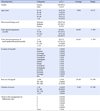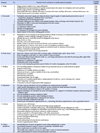Abstract
Purpose
This study was done to analyze the problems and desired work conditions of nursing organizations in small-medium hospitals.
Methods
Delphi Technique was used. In the first stage, the work conditions of nurses in small-medium hospitals were identified through a literature review. In the second stage, through 3 consultations with 20 nurse advisory groups, feedback was received on the desired work conditions for nurses in small-medium hospitals. In the third stage, 415 nurses and nurse managers were selected to examine the content validity and importance of the desired work conditions identified in the second stage.
Results
Sixty-four items were developed along eight domains of desired work conditions for nurses in small-medium hospitals. The survey on the desired work conditions revealed the following in order of importance: ‘wages’, ‘personnel’, ‘job’, ‘work hours’, ‘welfare’, ‘education’, ‘culture’, and and ‘other incentives’.
Figures and Tables
References
1. Korean Nurses Association. Why do nurses leave small-medium sized hospitals? In : Proceedings of Policy Forum; 2008 November 21; The National Assembly Library of the Republic of Korea. Seoul: Korean Nurses Association;2008.
2. Cotton JL, Tuttle JM. Employee turnover: a meta analysis and review with implication for research. Acad Manage Rev. 1986; 11(1):57–70. DOI: 10.5465/AMR.1986.4282625.
3. Ingersoll GL, Olsan T, Drew-Cates J, Devinney BC, Davis J. Nurses' job satisfaction, organizational commitment and career intent. Journal of Nursing Administration. 2002; 32(5):250–263. DOI: 10.1097/00005110-200205000-00005.

4. Institute of Medicine (US). Committee on the work environment for nurses and patient safety. Keeping patients safe: Transforming the work environment of nurses. Washington, D.C.: National Academies Press;2005.
5. Haynes VD. What nurses want. The Washington Post;2018. 09. 13. Sect. Business. Available from: http://www.washingtonpost.com/wp-dyn/content/article/2008/09/12/AR2008091203367.html?noredirect=on.
6. Duddle M, Boughton M. Development and psychometric testing of the nursing workplace relational environment scale (NWRES). Journal of Clinical Nursing. 2009; 18(6):902–909. DOI: 10.1111/j.1365-2702.2008.02368.x.


7. Aiken LH, Clarke SP, Cheung RB, Sloane DM, Silber JH. Educational levels of hospital nurses and surgical patient mortality. JAMA. 2003; 290(12):1617–1623. DOI: 10.1001/jama.290.12.1617.



8. Kazanjian A, Green C, Wong J, Reid R. Effect of the hospital nursing environment on patient mortality: A systematic review. Journal of Health Services Research & Policy. 2005; 10(2):111–117A. DOI: 10.1258/1355819053559100.


9. Friese CR, Lake ET, Aiken LH, Silber JH, Sochalski J. Hospital nurse practice environments and outcomes for surgical oncology patients. Health Services Research. 2008; 43(4):1145–1163.



10. Whitman GR, Kim Y, Davidson LJ, Wolf GA, Wang SL. The impact of staffing on patient outcomes across specialty units. Journal of Nursing Administration. 2002; 32(12):633–639. DOI: 10.1097/00005110-200212000-00008.

11. Ministry of Employment and Labor (KR). Labor standard act. Act No. 15513. 2018. 03. 20.
12. Kim MA, Park KO, You SJ, Kim MJ, Kim ES. A survey of nursing activities in small and medium-size hospitals: reasons for turnover. Journal of Korean Clinical Nursing Research. 2009; 15(1):149–165.
13. Korean Hospital Nurses Association. Survey on working condition of nursing workforce in hospitals (2016). Research survey. Seoul: Korean Hospital Nurses Association;2016.
14. Park SK, Cho KM, Jwa YG, Kang DW, Lee YJ. Survey of nurse activity status. Policy Report 2014-106. Chungju: Korea Health Industry Development Institute;2014.
15. Yang JH, Kwon YJ, Bak YS, Lee ES. A study on the nurse's turnover intention. J Inje Univ. 2005; 20(1):609–628.
16. Kim WK, Chung KH. The relationship between professional self-concept, organizational commitment and job satisfaction in clinical nurses. Journal of Korean Academy of Nursing Administration. 2008; 14(3):287–296.
17. An HG, Kang IS. Factors influencing organizational commitment and job satisfaction of nurses. Journal of Korean Academy of Nursing Administration. 2006; 12(4):604–614.
18. Korean Hospital Nurses Association. A survey on hospital nursing staffing (2016). Research survey. Seoul: Korean Hospital Nurses Association;2016.
19. Kang BS, Cho CH, Kim SH. Study on the effects of service quality on customer satisfaction and service performance on the small and medium hospital. Asia Pacific Journal of Small Business. 2005; 27(1):57–87.
20. Lee HK, Yang YH, Koo MO, Eun Y. Introduction of nursing research. 5th ed. Seoul: Hyunmoonsa;2014.
21. Korean Hospital Nurses Association. A survey on hospital nursing staffing (2013). Research survey. Seoul: Hospital Nurses Association;2013.
22. Park KO, Yu M, Kim JK. Experience of nurses participating in comprehensive nursing care. Journal of Korean Academy of Nursing Administration. 2017; 23(1):76–89. DOI: 10.11111/jkana.2017.23.1.76.

23. Kim SY, Park KO, Kim JK. Nurses' experience of incivility in general hospitals. Journal of Korean Academy of Nursing. 2013; 43(4):453–467. DOI: 10.4040/jkan.2013.43.4.453.


24. Park YW, Oh KH, Mun KH, Jeong MA, Shin HK, Lee HS, et al. A study for developing the effective working pattern for nurses in shift work. Research survey. Seoul: Korean Hospital Nurses Association;2003.
25. Korean Hospital Nurses Association. A survey on hospital nursing staffing (2015). Research survey. Seoul: Korean Hospital Nurses Association;2015.
26. Shin HY, Choi SS, Bae SH, Sim JY, Yook JH, Lee YY, et al. Investigation of new nurses education status. Research survey. Seoul: Korean Hospital Nurses Association;2010.
27. Kim SY, Kim JK, Park KO. The role experience of preceptor nurses in hospitals. Journal of Korean Academy of Nursing Administration. 2012; 18(1):33–45. DOI: 10.11111/jkana.2012.18.1.33.





 PDF
PDF ePub
ePub Citation
Citation Print
Print








 XML Download
XML Download